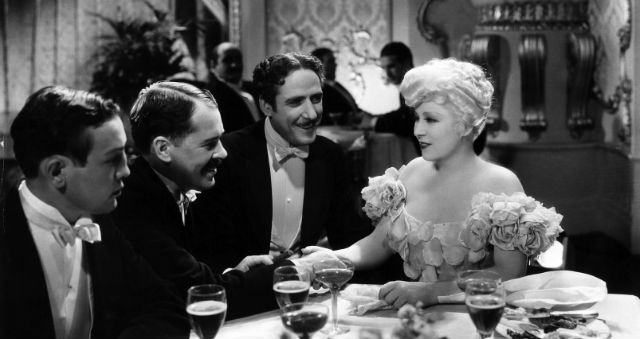Belle of the Nineties (1934) 
“The picture the whole country is talking about.”

Belle of the Nineties (1934)
Director: Leo McCarey
Cast: Mae West, Roger Pryor, Johnny Mack Brown
Synopsis: A singer moves to New Orleans after being jilted by her lover and becomes involved with a shady nightclub owner.
You have to wonder whether Mae West (Klondike Annie, The Heat’s On), the rather hefty star of Leo Mc Carey’s Belle of the Nineties, had something to do with the choice of chunky showgirls we see pounding the floorboards in the opening number of this vintage Paramount comedy-drama. West wasn’t exactly sylph-like herself, but her girdle-enhanced hour-glass figure looks positively svelte in her opening shot as she prepares for her own stage act, which consists of posing in front of different backgrounds while an off-stage crooner sings ‘American Beauty.’ You could be forgiven for thinking her character, Ruby Carter, makes a living as a quick-change artist, but she is, in fact, a singer who, by simply primping her hair with two fingers as she sashays around with her hand on one fulsome hip, reduces grown men to fawning doe-eyed puppies eager for a pat on the head.
Ruby’s enjoying a torrid (for 1934) affair with up-and-coming prize fighter Tiger Kid (forgotten B-movie star, Roger Pryor), much to the concern of the Kid’s manager, Kirby (James Donlan – The Painted Desert, The Front Page), who orchestrates a plan to trick his fighter into believing Ruby is cheating on him with another man. Dumped by the Kid (in a letter, no less – the 19th-Century equivalent of a text message), Ruby accepts an offer to play at oily businessman Ace Lamont’s (John Miljan – Flesh) Sensation House in New Orleans, and naturally goes down a storm with men fall- well, you know the drill. Lamont isn’t immune to Ruby’s ample charms, either, which doesn’t go down too well with his sultry but hot-headed girlfriend, Molly (Katherine DeMille), but Ruby is too distracted by the glittering diamonds offered to her by a second suitor, the nice, well-to-do Brooks Claybourne (Johnny Mack Brown) to take much notice of Ace. Things get complicated, though, when Tiger Kid shows up in town for a fight, and the couple realise that they were duped by Kirby.
West was big news in 1934, following the success of She Done Him Wrong and I’m No Angel, two racy movies which had transformed the fortunes of the ailing Paramount Studios. Unfortunately, the Hays Code, which came into full force two months before Belle of the Nineties was released, had no time for her raunchy brand of humour, and her film career never really regained the dizzy heights to which it had climbed in 1933. She tried to get around the Code’s puritanical edicts by submitting a script she knew would be rejected in the hope that including excessive scenes – which she had no intention of including – would make the near-the-knuckle moments she did want to film seem less outrageous. Unfortunately, it was a ploy that didn’t work and, like most of her post-1933 output, Belle of the Nineties is a pale imitation of West’s earlier movies.
Even the watered-down version of the film suffered numerous cuts at the hands of the censors, many of which are plain to see in the abrupt conclusion to some scenes, and confusion in others. There’s a scene early on in which Ruby and the Kid decide to cosy up in her apartment for the duration of a downpour while the sodden Kirby lurks outside. When Kid throws him an umbrella from the apartment window Ruby phones the police who promptly cart the sodden manager away. In the following scene we see the Kid saying goodbye to the unseen Ruby. In the original script, that deluge lasts for five days, after which the Kid is seen staggering from the tireless Ruby’s boudoir. That pretty much sums up how completely the Code de-clawed West’s salty humour. Thankfully, a few of those insouciant throwaway quips for which she was so famous did survive. “Better to be looked over than overlooked,” she comments as she’s the ogling of a group of admirers; “Are you in town for good?” asks yet another admirer, “I’m in town,” replies Ruby, “but not for good.”
Belle of the Nineties boasts a reasonable budget and production values for the time, and some strong musical numbers. If it were anyone else but West in the lead role it would probably seem to be a much better movie – not because West is poor, but simply because we expect a lot more raunch from her than we ever do from other actresses of the era.
(Reviewed 9th March 2016)
httpv://www.youtube.com/watch?v=WMdxclM6ERk

